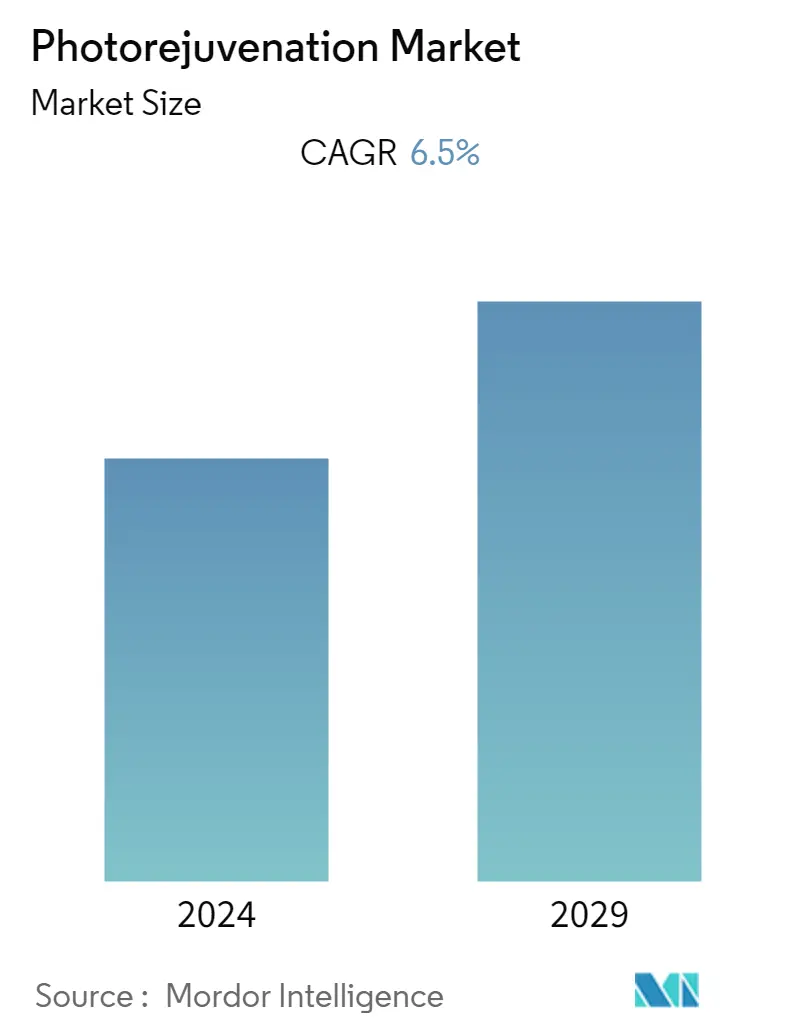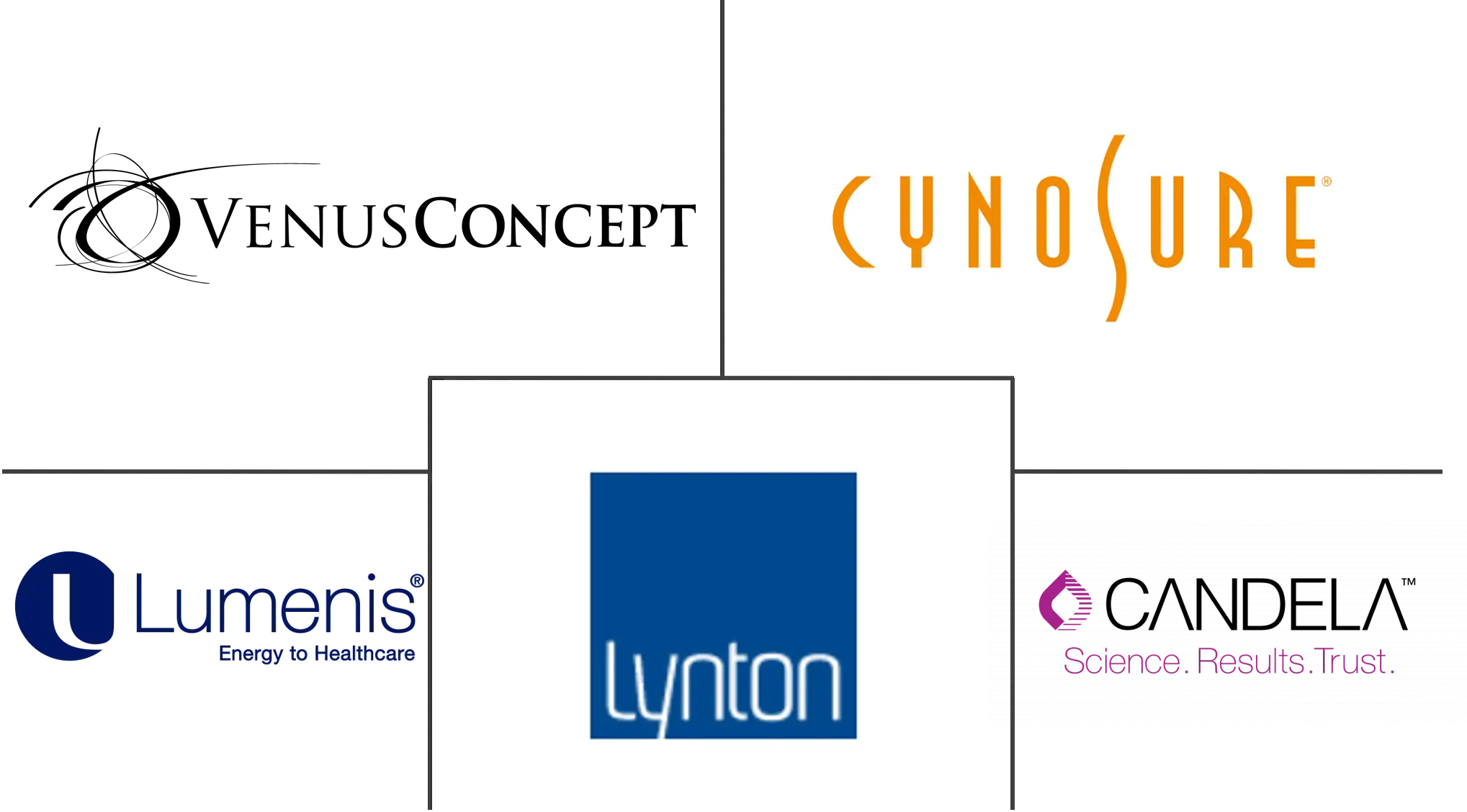Market Size of Photorejuvenation Industry

| Study Period | 2019 - 2029 |
| Base Year For Estimation | 2023 |
| Forecast Data Period | 2024 - 2029 |
| CAGR | 6.50 % |
| Fastest Growing Market | Asia Pacific |
| Largest Market | North America |
Major Players
*Disclaimer: Major Players sorted in no particular order |
Photorejuvenation Market Analysis
The photorejuvenation market is expected to register a CAGR of 6.5% over the forecast period.
The COVID-19 pandemic had a significant impact on the photorejuvenation market. However, the strict lockdowns and government regulations slowed down the spread of COVID-19, which increased the demand for aesthetic treatments. For instance, according to an article published by PubMed Central in October 2021, a study was conducted among dermatologists in the United States, which showed that consultations for cosmetic or aesthetic procedures increased by more than 50%. Another study stated that more than 57% of the patients had an increased interest in cosmetic procedures on the face. According to the article published by Dovepress in July 2022, 91% of patients continued their aesthetic treatment despite the pandemic, and 75% of patients reported new interest in proceeding with treatments not previously tried. Currently, the market has regained its momentum with ease in restrictions.
The key contributors to the market growth are the rising burden of skin diseases and the rising preferences of people toward non-invasive procedures. According to an article published by the Journal of the European Academy of Dermatology & Venerology in March 2022, a population-based study was conducted in Europe, which showed that 43.35% of people had suffered from at least one dermatological condition during the last year. It is estimated that more than 94 million Europeans complain of having uncomfortable skin sensations like an itch, burning sensation, or dryness.
According to an article published by Nature in October 2022, a study was conducted in the Thai population, which showed that the overall prevalence of skin diseases was close to 7%, and skin diseases like dermatitis, bacterial skin infection, and urticaria were the most common among them. Hence, such factors are expected to fuel the demand for photorejuvenation procedures in the future.
In addition, new product launches and strategic activities by major players in the market are positively affecting the growth of the studied market. For example, in March 2022, Cynosure, a company focused on manufacturing and developing energy-based aesthetic and medical treatment systems, entered a distribution partnership with Jeisys Medical KK in Japan. Under the terms of the agreement, Jeisys Medical will have exclusive distribution rights for key premier products within Cynosure's energy-based laser portfolio, including photorejuvenation devices, in Japan.
Therefore, owing to such factors, the photorejuvenation market is anticipated to witness growth over the forecast period. However, the high cost of devices is likely to impede the market's growth.
Photorejuvenation Industry Segmentation
As per the scope of the report, photorejuvenation is a type of skin treatment that helps in treating skin conditions and reducing photoaging, such as wrinkles, texture, and other conditions.
The photorejuvenation market is segmented by product (intense pulsed light, laser equipment, and LED equipment), modality (standalone and portable), end user (hospitals, dermatology clinics, and other end users), and geography (North America, Europe, Asia-Pacific, and Rest of the World). The report offers the value (USD million) for the above segments.
| By Product | |
| Intense Pulsed Light | |
| Laser Equipment | |
| LED Equipment |
| By Modality | |
| Standalone | |
| Portable |
| By End User | |
| Hospital | |
| Dermatology Clinics | |
| Other End Users |
| Geography | ||||||||
| ||||||||
| ||||||||
| ||||||||
| Rest of the World |
Photorejuvenation Market Size Summary
The photorejuvenation market is poised for growth, driven by an increasing preference for non-invasive aesthetic procedures and the rising prevalence of skin diseases. The market's recovery post-COVID-19, where demand for aesthetic treatments surged despite the pandemic, highlights the resilience and growing interest in cosmetic procedures. The market is further bolstered by strategic partnerships and product launches by key players, such as Cynosure's collaboration with Jeisys Medical in Japan, which enhances the availability of advanced photorejuvenation devices. However, the high cost of these devices remains a challenge to market expansion.
Intense pulsed light technology is a significant segment within the photorejuvenation market, offering precise and efficient treatment for various skin conditions simultaneously. The adoption of this technology is supported by continuous product innovations, such as Quantel Medical's C.STIM system and Ulike's next-generation IPL devices. North America leads the market, driven by a growing geriatric population and the effective use of photorejuvenation therapy. The region's market growth is supported by frequent product launches and a high concentration of industry players. The market's fragmented nature, with numerous global and regional companies, underscores the competitive landscape, with major players like Venus Concept, Cynosure Inc., and Lumenis holding significant shares.
Photorejuvenation Market Size - Table of Contents
-
1. MARKET DYNAMICS
-
1.1 Market Overview
-
1.2 Market Drivers
-
1.2.1 Rising Number of Cases Related to Skin Diseases
-
1.2.2 Rising Preferences of Non-invasive Methods
-
-
1.3 Market Restraints
-
1.3.1 High Cost of Devices
-
-
1.4 Porter's Five Forces Analysis
-
1.4.1 Threat of New Entrants
-
1.4.2 Bargaining Power of Buyers/Consumers
-
1.4.3 Bargaining Power of Suppliers
-
1.4.4 Threat of Substitute Products
-
1.4.5 Intensity of Competitive Rivalry
-
-
-
2. MARKET SEGMENTATION
-
2.1 By Product
-
2.1.1 Intense Pulsed Light
-
2.1.2 Laser Equipment
-
2.1.3 LED Equipment
-
-
2.2 By Modality
-
2.2.1 Standalone
-
2.2.2 Portable
-
-
2.3 By End User
-
2.3.1 Hospital
-
2.3.2 Dermatology Clinics
-
2.3.3 Other End Users
-
-
2.4 Geography
-
2.4.1 North America
-
2.4.1.1 United States
-
2.4.1.2 Canada
-
2.4.1.3 Mexico
-
-
2.4.2 Europe
-
2.4.2.1 Germany
-
2.4.2.2 United Kingdom
-
2.4.2.3 France
-
2.4.2.4 Italy
-
2.4.2.5 Spain
-
2.4.2.6 Rest of Europe
-
-
2.4.3 Asia-Pacific
-
2.4.3.1 China
-
2.4.3.2 Japan
-
2.4.3.3 India
-
2.4.3.4 Australia
-
2.4.3.5 South Korea
-
2.4.3.6 Rest of Asia-Pacific
-
-
2.4.4 Rest of the World
-
-
Photorejuvenation Market Size FAQs
What is the current Photorejuvenation Market size?
The Photorejuvenation Market is projected to register a CAGR of 6.5% during the forecast period (2024-2029)
Who are the key players in Photorejuvenation Market?
Venus Concept, Cynosure Inc., Lumenis, Lynton and Candela Medical are the major companies operating in the Photorejuvenation Market.

